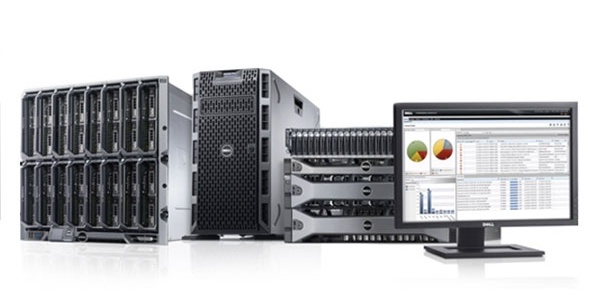Dell details PowerEdge 12G servers ahead of Xeon E5

Dell's PowerEdge 12G family of servers has been updated with Intel's Xeon E5 processors, more system management and the ability to use a Dell-developed PCIe-linked flash storage and cache system.
The 12th Generation PowerEdge family of servers was unveiled at a press event in London on Monday. The servers should be available "in the near future", the company said, but did not give prices or detailed specification as they are based around Intel's yet-to-launch Xeon E5 processor.

Dell has introduced the latest servers in its PowerEdge range, the 12G family of servers. Image credit: Dell
"[They] build on 11G," Brad Anderson, Dell's head of enterprise solutions, told ZDNet UK. "We're taking it to applications and workloads and it's a very balanced system which is a combination of I/O, compute and storage."
The servers are designed for a variety of workloads, the company said, ranging from high-end database processing to low-end tasks for small businesses. The family spans industry standard racks, towers and blades.
The entire range supports 10GbE networking and uses undisclosed technology from Dell's Force10 Networking acquisition. All the servers have iDRAC7 with Lifecycle Controller — Dell software that gives status updates on individual servers and has diagnostics for identifying errors.
For heavily virtualised environments, the T620 tower server supports up to 24 memory slots, which can scale to 768GB of RAM, while the PowerEdge R620 has the same. The two-socket R720xd has the same along with up to 24 2.5-inch or 12 3.5-inch drives.
A key differentiator between Intel's Xeon E5 'Romley' processor and its Westmere predecessors is support of the PCI 3.0 communications protocol, allowing for 1GBps per lane of communication in and out of the processor, Anderson said.
"It's a good step function generation-over-generation improvement," he said, before hinting that Dell is looking to take customers from its rival, HP, who are thinking of migrating their applications away from the Itanium RISC-architecture processors.
"I don't think there are workloads... on RISC that can't be done on [Romley] x86," he added.
Anderson hasn't seen the move to cloud crimp small business demand for servers.
"Despite it being forecast for a while that SMEs are going to be the biggest consumer of cloud resources, I see a growth in demand from SMEs for Dell servers," he said.
Entering the PCIe flash game
The company also announced its entrance into PCIe-linked flash with its Dell Express Flash (PDF) technology, following in the footsteps of EMC's VFCache technology, which in turn followed Fusion-io's ioDrive technology. PowerEdge Express Flash PCIe SSD uses 34nm SLC flash and will be available in 175GB and 350GB capacities. It promises 1.8GBps sequential reads and 1.2GBps writes, using 128KB blocks.
The product is a hot swappable PCIe-linked flash card that can go directly into Dell servers to boost the performance of I/O intensive applications. Dell also said it would be introducing a similar technology for caching, called Dell CacheCade data accelerator, but gave no details.
The technology is going to be an important one from Dell as the company plans to integrate some of the memory pooling technology it acquired from RNA Networks, Anderson said, and indicated there will be a technical announcement in June.
"Obviously flash in the server gives customers tremendous value," he said. "It allows you to do certain things [but] wouldn't it be exciting if that could also be tier zero of a storage device?"
Get the latest technology news and analysis, blogs and reviews delivered directly to your inbox with ZDNet UK's newsletters.